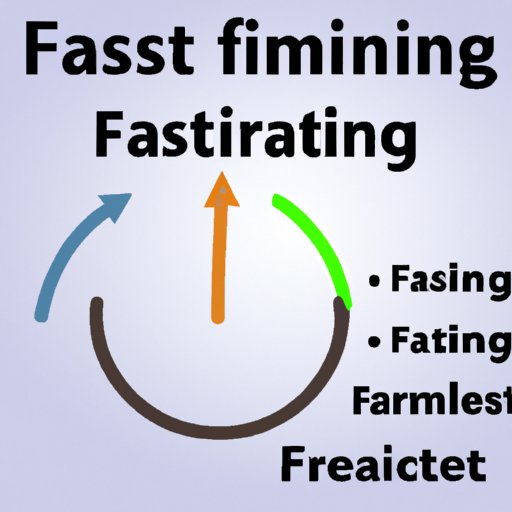
Introduction
If you’re looking to lose weight, fasting could be the answer you’re looking for. Fasting has been shown to be an effective weight loss strategy for many people, and it’s a safe and healthy way to get results without unsustainable restrictive diets or supplements. In this article, we’ll dive into the top 5 fasting techniques for weight loss, the science behind why fasting works, and tips for how to safely and effectively incorporate fasting into your lifestyle.
The Top 5 Fasting Techniques to Combat Weight Gain
Fasting is the intentional abstention from eating for extended periods of time. There are many different fasting techniques to choose from, depending on your goals and lifestyle. Here are the top five fasting techniques for weight loss:
- Intermittent fasting: This involves alternating periods of fasting and eating, with a typical cycle lasting 16-24 hours. This is an effective way to reduce your daily calorie intake and increase weight loss.
- Time-restricted feeding: This involves consuming all your meals within a specific time frame, typically 8-10 hours. This technique helps regulate your metabolism and improve insulin sensitivity.
- Alternate day fasting: This involves fasting every other day, with a calorie-restricted diet on your non-fasting days. This technique helps reduce calorie intake and increases weight loss.
- Extended fasting: This involves fasting for longer periods, typically 24-72 hours. This technique is best for experienced fasters and can have significant weight loss benefits.
- Spontaneous meal skipping: This technique involves occasionally skipping meals when you aren’t feeling hungry. While it’s not a true fast, it can be an effective way to reduce your calorie intake and promote weight loss.
It’s important to note that fasting isn’t a quick fix or a magic solution for weight loss. It’s a tool that, when used correctly, can help you achieve your goals in a healthy way.
The Connection Between Fasting and Weight Loss
So, how exactly does fasting lead to weight loss? The science behind it is rooted in how fasting affects our hormones and metabolism. When we fast, our insulin levels drop and our bodies begin using stored fat for energy. This leads to increased fat burning and weight loss. Additionally, fasting has been shown to improve insulin sensitivity, lower inflammation, and increase metabolism.
Breaking a fast properly is also crucial for successful weight loss. It’s important to break a fast with healthy, nutrient-dense foods to avoid overeating and weight gain. Foods like lean proteins, healthy fats, and fibrous vegetables are good choices that will keep you feeling full and satisfied.
Fasting for Beginners: How to Successfully Lose Weight Through Fasting
If you’re new to fasting, it’s important to take it slow and listen to your body. Here are some tips for getting started with fasting:
- Choose the right fasting technique: Experiment with different fasting techniques to find what works best for you.
- Prepare your body: Gradually ease into fasting by cutting back on calories and avoiding processed foods leading up to your fast.
- Stay hydrated: Drink plenty of water and unsweetened beverages to keep your body hydrated.
- Stay busy: Keep your mind off food by staying active and busy during your fast.
- Break your fast with healthy foods: Eat nutrient-dense foods to avoid overeating and weight gain.
It’s important to remember that fasting isn’t for everyone. If you have a history of disordered eating or medical issues, speak with your healthcare provider before starting any fasting regimen.
Maximizing Your Weight Loss Efforts with Fasting
While fasting alone can lead to weight loss, combining it with other healthy habits can lead to even greater results. Here are some tips for incorporating fasting into a healthy lifestyle plan:
- Exercise regularly: Regular exercise can help accelerate weight loss and improve overall health.
- Eat a balanced diet: Focus on consuming whole, nutrient-dense foods to support your body and your weight loss goals.
- Track your progress: Keep track of your progress and adjust your fasting and eating habits accordingly.
- Stay motivated: Use positive affirmations, motivational quotes, or rewards to stay disciplined and motivated throughout your weight loss journey.
Fasting Myths Debunked: What You Need to Know
There are a lot of myths and misconceptions surrounding fasting and weight loss. Here are some common myths and the truth behind them:
- Fasting leads to muscle loss: While fasting can lead to some muscle loss, this can be counteracted by strength training and consuming enough protein.
- Fasting slows down your metabolism: Fasting has actually been shown to increase metabolism and improve metabolic flexibility.
- Fasting is dangerous: When done correctly and with medical supervision, fasting can be a safe and effective weight loss strategy.
- Fasting leads to overeating: While some people may overeat after fasting, others may experience less hunger and consume fewer calories overall.
Conclusion
Overall, fasting can be a healthy and effective weight loss strategy when done correctly. It’s important to choose the right fasting technique, break your fast with healthy foods, and stay motivated to achieve your goals. Remember to listen to your body and speak with your healthcare provider before starting any fasting regimen.




